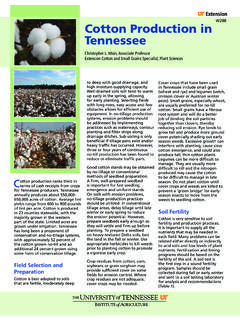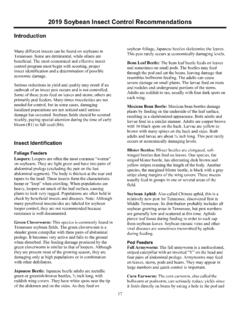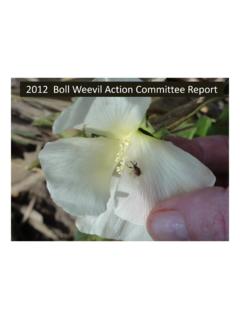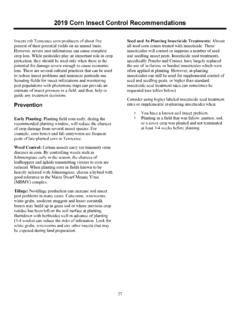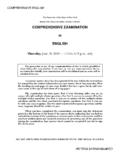Transcription of Soybean Disease and Nematode Identification …
1 Heather M. Kelly, Assistant ProfessorField Crops Plant PathologistEntomology & Plant PathologyUniversity of Tennessee ExtensionSoybean Disease and Nematode Identification Field Guide TABLE OF CONTENTS Frogeye Leaf Spot (FLS) .. 2 Southern Stem Canker .. 3 Sudden Death Syndrome (SDS) .. 4 Soybean Rust (SBR).. 5 Septoria Brown Spot .. 6 Cercospora Blight .. 7 Charcoal Rot .. 8 Anthracnose .. 9 Southern Blight or Sclerotium Blight .. 10 Phytophthora Rot .. 11 Downy 12 Soybean Cyst Nematode (SCN) .. 13 Tebuconazole Phytotoxicity .. 14 1 Frogeye Leaf Spot (FLS) (Cercospora sojina) Symptoms: Leaf lesions are circular with a purple margin around a tan/grey center.
2 Lesions begin as dark, water-soaked spots on the younger leaves. As lesions age, the centers become ash-gray-to-light-brown. Sporulating lesions on the lower surfaces of leaves are darker and have light-to-dark-gray centers with clusters of conidiophores and thin, reddish-brown margins. Non-sporulating older lesions are light-to-dark-brown, translucent, and have white centers containing minute, dark stromata. These lesions may coalesce to form larger, irregular spots. Management: Plant FLS resistant varieties Timely fungicide application when warranted will control Disease Top side of leaf Bottom side of leaf 2 Southern Stem Canker (Diaporthe phaseolorum var.)
3 Meridionalis) Symptoms: First symptoms of stem canker appear as small reddish brown spots on stems near a lower node. These spots develop into cankers that can be several inches long running up the stem from the point of infection but only on one side (Picture 1 & 2). As the plant dies and the stem turns brown, the cankers are difficult to distinguish from the rest of the stem tissue. Leaf symptoms first appear as yellowing between the veins being more apparent on one side of the affected leaves (Picture 3). These leaves later turn brown and die but remain stuck to the stem, similar to plants affected by charcoal rot.
4 Affected dry plants can easily break over when pushed. The pith of the stems will turn a light brown instead of remaining white and healthy (Picture 4). In some cases, the Dectes stem borer may have caused a dark- brown pith. Management: Stem canker resistant varieties should be planted especially in fields that have had a history of stem canker. Infected crop debris can cause Disease up to 18 months; hence a 2 year rotation is necessary to rid fields of stem canker. Picture 2 Picture 3 Picture 4 Picture 1 Canker on one side of stem Yellowing between veins more apparent on one side of affected leaves Light brown pith of infected plant with stem canker 3 Sudden Death Syndrome (SDS) (Soil-borne, Fusarium solani f.)
5 Sp. glycines) Symptoms: Usually begin during the flowering stage and get progressively worse through R6. First appear as small yellow spots (Picture 1) in the upper leaves and progress into yellow streaks and then become necrotic with only the veins remaining green (Picture 2). The leaves may fall and leave the petioles attached. The foliar symptoms may resemble those of stem canker, charcoal rot, and tebuconazole burn. Roots of infected plants are usually rotted, and plants can be easily pulled out of the soil. The pith tissue will remain white, while the water-conducting tissue (xylem) will have a gray-to-brown color (Picture 3), extending from the root area into the stem.
6 Many times SDS symptoms will be more severe in the presence of the Soybean cyst Nematode and may be worse after rotation with corn that had severe stalk rot the previous year. Management: SDS resistant varieties should be planted especially in fields that have had a history of SDS. Cultural practices that improve drainage in low spots, reduce Soybean cyst nematodes, or remove soil compaction may lessen SDS severity as well as delaying planting or using an early-maturing cultivar. Picture 1 Picture 2 Picture 3 4 Soybean Rust (SBR) (Phakopsora pachyrhizi) Symptoms: Raised pimple-like structures called uredinia (volcanoes) develop in angular lesions, mostly on the underside of leaves, and release spores through central holes called ostioles.
7 Uredinia first appear on leaves in the center and lower canopy. Lesions resemble those of bacterial pustule, but differences can be seen with a 30X hand lens or a low power microscope. The opening in the pimple-like structure of bacterial pustule is an irregular crack with no rust-like spores. Uredinia circular openings and spores inside are diagnostic. Irregular dark brown leaf spots caused by Septoria brown spot can also be confused with Soybean rust. However, those lesions are flat and do not develop raised pustules or ostioles.
8 Management: Timely fungicide application when warranted will management yield loss from SBR infection. 5 Septoria Brown Spot (Septoria glycines) Symptoms: Irregular, dark brown spots appear on upper and lower leaf surfaces of both unifoliate and trifoliate leaves. Adjacent lesions may coalesce to form irregularly shaped blotches. These lesions darken until they become blackish-brown. During wet, warm weather, lesions rapidly spread to all leaves and cause premature defoliation. Small brown lesions can occur on stems, branches, petioles and pods but are not sufficiently distinct to be diagnostic as herbicide burns early in the season look very similar.
9 Management: Timely fungicide application when warranted will control Disease . 6 Cercospora Blight (Cercospora kikuchii) Symptoms: Upper leaves exposed to the sun develop light-to-dark-purple areas, depending on variety. This discoloration can deepen and extend over the entire upper surfaces of affected leaves, giving them a leathery, dark, reddish-purple appearance, highlighted with bronzing. Numerous infections cause rapid chlorosis and necrosis of leaf tissues, resulting in defoliation, starting with the upper leaves.
10 These symptoms are often mistaken for early senescence. Purple seed stain varies from pink or pale purple to dark purple. Infected seed may not show any symptoms. Management: Plant cultivars with resistance. Timely fungicide application when warranted will control Disease . 7 Charcoal Rot (Macrophomina phaseolina) Symptoms: Appear during the reproductive stages of Soybean development. Leaflets are small and show loss of vigor. Later leaves yellow, wilt, and turn brown but remain attached to the petioles, as in stem canker.
